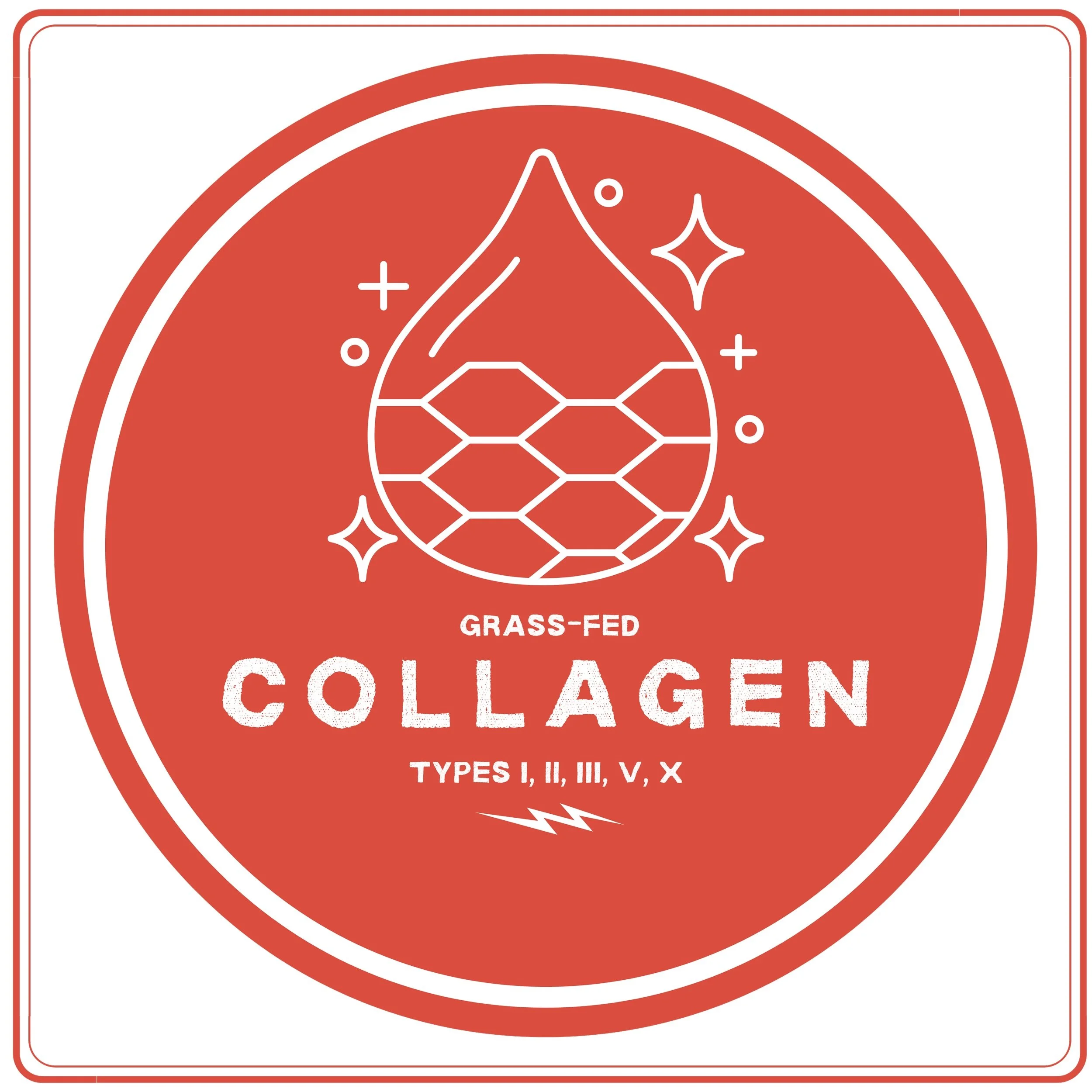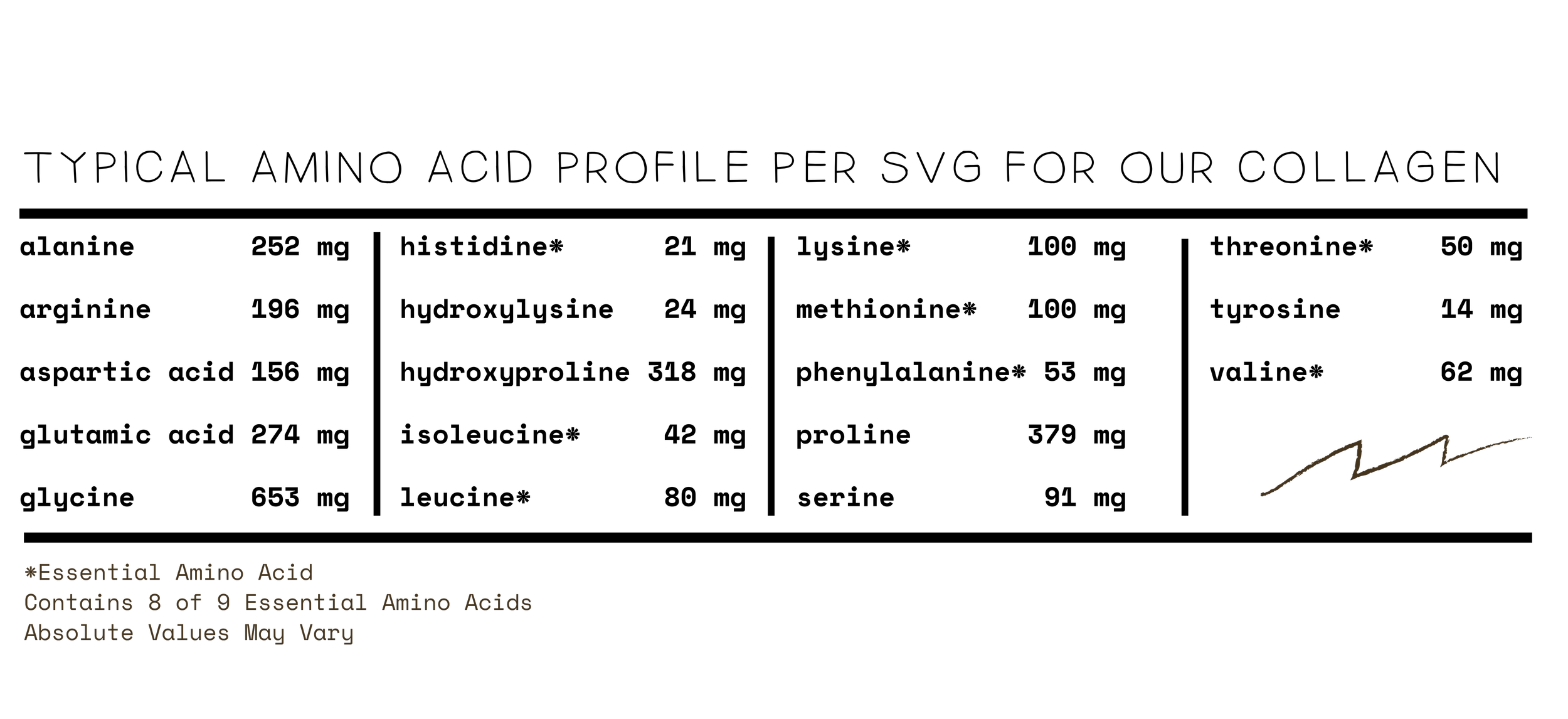collagen 101
Collagen is the most abundant protein in the human body. It’s made by cells in your connective tissue called fibroblasts that are responsible for assembling 3 amino acids (glycine, proline, and hydroxyproline) into chains that form collagen’s familiar triple helix structure. This combination of peptides (2-3 amino acids strung together in a chain) is what makes collagen collagen. This synthesis also requires other nutrients, enzymes, and cofactors, like vitamin C, copper, and zinc. Without those nutrients, your body won’t make collagen.
And that’s a bad thing, because collagen is a key component of connective tissue, which provides structure, support, elasticity, and strength to skin, tendons, cartilage, muscle, ligaments, and bones, as well as a variety of other tissues, which will be discussed shortly.
But for now, you know that youthful complexion with radiant, glowing skin, strong nails, shiny hair, flexible joints, and strong bones we associate with being young? That’s primarily thanks to collagen.
GUT CHECK
Collagen also benefits the gut by supporting the integrity of the gut lining and promoting a healthy intestinal barrier, while helping to prevent leaky gut — keeping the good stuff in and the bad stuff out. Additionally, collagen can reduce inflammation in the gut, help modulate the immune system, and help stimulate the production of stomach acid.
Which is a good thing, because collagen production in the body ultimately begins with a healthy gut, or more specifically, adequate amounts of stomach acid, which is necessary to break down the proteins you eat and cleave away those amino acids that make up collagen. Interestingly, zinc is also needed to make stomach acid, and in order to ABSORB zinc, you need healthy amounts of stomach acid.
ANYWHOOSIES...
Our wonderfully made bodies are always balancing the production and degradation of collagen. When we’re young, we make more than we break down, and that balance peaks in our mid-20s. But as we age, the scale begins to tip in the other direction, falling at a rate of about 1.5% per year.
And then around our mid-40s, we’re hit with a more significant drop of around 30% (primarily due to hormonal shifts and aging fibroblasts), and the familiar signs of aging start showing up as things like wrinkles, cellulite, thin, sagging skin, dull hair, brittle bones and nails, and joint pain.
Thankfully, the decline starts leveling off back towards a 1.5% yearly drop. But if you do the math, this means by the time you’re around 50 years old, your collagen levels have dropped by about 60%...and by the time you’re 60, it’s around 80%.
And that’s IF you don’t have poor gut health, nutrient deficiencies, smoke, have chronic stress, spend TOO MUCH time baking in the sun, or aren’t exposed to environmental pollution...all of which accelerate collagen depletion and more signs of aging.
Now, of course, my first recommendation to improve collagen production and healthy aging would be to focus on improving gut health, managing stress, exercising regularly, and eating a healthy diet — especially foods rich in vitamin C...which always makes sense no matter what, young or old.
Outside of that, supplementing with collagen would be my next recommendation. But which kind and how much?
I’M GLAD YOU ASKED
First, look for “Hydrolyzed collagen peptides”, “Collagen Hydrolysate”, or “Collagen Peptides”, which basically means the collagen molecule has been fully broken down 50-100 times smaller (through hydrolysis, which allows it to dissolve easily in cold water) into digestible, short chains of amino acids (peptides). This essentially allows you to “bypass” a potentially defunct gut (where natural enzymatic hydrolysis would occur) so that your body can use those amino acids as is without having to do the work of breaking down the proteins first.
However, even with collagen supplementation, you still need to consume a healthy amount of protein daily AND have a healthy gut to break that protein down because collagen isn’t a complete protein - meaning, it doesn’t contain all 9 of the essential amino acids that the body can’t produce itself.
A good collagen supplement will contain 8 of them (phenylalanine, valine, threonine, isoleucine, methionine, histidine, leucine, and lysine)…but none of them will naturally contain tryptophan - which is actually a good thing, in my opinion. If yours does, it’s likely added after hydrolysis…but that doesn’t make it better. In fact, it could make it worse, especially if you’re inflamed. In total, there should be at least 18 different amino acids in your collagen supplement.
It's also important to know that since collagen doesn't contain tryptophan, do NOT think that you're getting enough protein in your diet just because you supplement with collagen. Remember, tryptophan is an ESSENTIAL amino acid, so if you're not eating enough protein daily or if you have poor gut health, you can become deficient in tryptophan, which can increase your risk of things like anxiety and panic attacks. But that's a bigger discussion for another day.
But just how much of those amino acids and which ones make it into your supplement depends on the source(s) of protein and which types of collagen are used.
WHAT TYPES OF COLLAGEN ARE THERE?
Though there are disagreements on the number of different types of collagen in your body (some say 16, while others say 28 or more), the most common types are type I, type II, and type III — but other types, though less abundant, are still equally vital to a healthy body. When supplementing with collagen, the more types there are, the better, thanks to multiple amino acid sequence combinations.
When I formulated Thunderbird coffee, I chose to use five types, rather than the standard one or two, in order to maximize the benefits to your body. They are:
TYPE I - makes up about 80% of the collagen in your body; found in skin, tendons, ligaments, bone, eyes, nails, organs, blood vessels (SUPER IMPORTANT), hair, and other connective tissues.
TYPE II - provides elasticity, flexibility, repair, and maintenance to cartilage, bones, joints, the eyes, and the gut lining.
TYPE III, V, and X - provides structure and support to skin, blood vessels (SUPER IMPORTANT), the placenta, muscles, hair, the basement membrane (which separates the epidermis from the dermis in the skin), and organs such as the intestines, liver, and uterus.
WHAT ABOUT WHERE IT’S SOURCED FROM?
Most collagen supplements only contain types I and III...which is typically obtained from boiling the bejeezus out of cow hides...and which typically came from cows raised inhumanely in CAFO lots fed on an unnatural diet of GMO corn and given growth hormones and antibiotics...because it’s cheap...for them, but comes at quite a cost for you, both literally and figuratively.
As you can imagine, it wasn’t enough for me to use multiple types of collagen; it was also equally important to consider the source. The various types of collagen I use in Thunderbird come from humanely-raised, grass-fed, pasture-raised, BSE-free, non-GMO, organic bovine and poultry bone broths and eggshell, as well as wild-caught cod and snapper.
Grass-fed, pasture-raised collagen sources have been shown to be more easily absorbed by the body and may contain a better nutrient profile, including essential fatty acids, vitamins A and E, and minerals such as zinc and magnesium...thanks to the animal eating a more natural and nutritious diet.
WHAT ABOUT THE DOSE?
Studies and anecdotal evidence show that as little as 2.5 grams can have amazing benefits for skin health, with higher doses from multiple types and quality sources offering even more benefits.
Formulating Thunderbird with a healthy dose of collagen was perhaps the most challenging aspect of the recipe, because as important and beneficial as collagen is, using a higher dose per serving (say, 5 grams) would result in a lower bag yield of servings per 341 gram (12 oz) bag. I could’ve offered a 454 gram (16 oz) bag to increase the yield, but it would’ve also meant having to charge around $45 per bag...which is what many functional coffee companies charge for a 12 oz bag WITHOUT the quality, standards, dosing, and variety of ingredients I use in Thunderbird.
So after muuuuuuuuch tinkering with formulas and numbers, I settled on 2.8 grams of collagen peptides per serving. This amount gives you an excellent dose in one serving, while still offering a good bag yield of servings. It also allows me to be able to offer it at a better price to you while maintaining profitability for Astro Botanico. And since I use multiple types from multiple quality sources, the benefits to you at a 2.8 gram dose are also much better for you overall.
And that is what we call a “win-win” for everybody.


